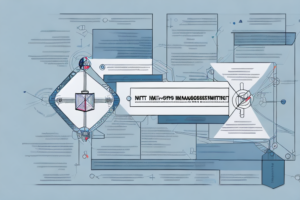What is information system boundary in RMF?
7 min read
A wall with a door in the center
In order to effectively manage cybersecurity risks, the National Institute of Standards and Technology (NIST) developed the Risk Management Framework (RMF). One key aspect of RMF is the definition and maintenance of information system boundaries.
Understanding the basics of RMF
Before delving into the specifics of information system boundaries, let’s briefly review the basics of RMF. RMF is a structured, cyclical approach to managing cybersecurity risk. It involves several steps, including categorization, selection of security controls, implementation of controls, assessment of controls, authorization, and ongoing monitoring. At each step, specific guidance and processes are followed to ensure that risks are identified and appropriately mitigated.
One important aspect of RMF is the continuous monitoring of security controls. This involves regularly assessing the effectiveness of implemented controls and identifying any new risks that may have emerged. It is important to note that cybersecurity risks are constantly evolving, and what may have been effective in the past may no longer be sufficient. Therefore, ongoing monitoring and updating of security controls is crucial to maintaining a strong cybersecurity posture.
What are information system boundaries?
Information system boundaries refer to the physical, logical, or virtual boundaries that define the scope of an information system. These boundaries are necessary to ensure that all components of the system are identified and properly secured. Information system boundaries can include hardware, software, networks, data, and personnel.
One important aspect of information system boundaries is that they help to establish accountability for the system. By defining the boundaries, it becomes clear who is responsible for the various components of the system and who is accountable for any breaches or failures that occur.
Another key benefit of information system boundaries is that they help to ensure compliance with regulations and standards. By clearly defining the scope of the system, it becomes easier to identify which regulations and standards apply and to ensure that the system meets all necessary requirements.
Different types of information system boundaries in RMF
There are several different types of information system boundaries that may be relevant when implementing RMF. These include functional, physical, and operational boundaries. Functional boundaries define the specific applications or services that will be included in the information system. Physical boundaries refer to the physical infrastructure that supports the information system, such as servers, routers, and switches. Operational boundaries specify the policies and procedures that govern the operation of the information system.
Another type of information system boundary that is important to consider in RMF is the data boundary. This refers to the specific data that is included in the information system and how it is managed and protected. Data boundaries can include data classification, data storage, and data access controls. It is important to establish clear data boundaries to ensure that sensitive information is properly protected and that data is only accessed by authorized personnel.
Why is information system boundary important in RMF?
Defining and maintaining clear information system boundaries is essential for effective risk management under RMF. Without clear boundaries, it can be difficult to identify all the components of the information system that require protection. This can lead to gaps in security that put the system at risk for cyberattacks or other security incidents.
Furthermore, having a clear understanding of the information system boundary helps in determining the scope of the risk assessment. This ensures that all the relevant components of the system are included in the assessment, and potential risks are identified and addressed. It also helps in identifying the security controls that need to be implemented to protect the system.
Another reason why information system boundary is important in RMF is that it helps in compliance with regulatory requirements. Many regulations require organizations to define and maintain clear boundaries for their information systems. By doing so, organizations can demonstrate compliance with these regulations and avoid penalties or legal consequences.
How to define information system boundary in RMF
Defining information system boundaries requires careful consideration of several factors. One of the first steps is to identify the specific functions and services that will be included in the system. This can involve conducting a thorough inventory of all hardware and software assets, as well as identifying the specific data that will be processed or stored within the system.
Next, it is important to understand the specific risks that are associated with each component of the system. This can involve assessing the potential impact of different types of security incidents, as well as identifying vulnerabilities that may exist within the system.
Finally, the information system boundary needs to be clearly documented and communicated to all relevant parties. This documentation should include a clear definition of the system boundary, as well as any specific policies or procedures that are necessary to maintain the boundaries and ensure the security of the system.
It is also important to regularly review and update the information system boundary as needed. This can involve conducting periodic risk assessments to identify any new threats or vulnerabilities that may have emerged since the initial boundary was established. Additionally, changes to the system, such as the addition of new hardware or software, may require a reassessment of the boundary to ensure that it remains effective in protecting the system and its data.
Factors to consider when defining information system boundary in RMF
When defining information system boundaries, there are several key factors to consider. These include the specific functions and services provided by the system, the types of data that will be processed or stored within the system, the physical and logical infrastructure supporting the system, and the specific risks associated with each component of the system. Additionally, it is important to consider any relevant regulatory or compliance requirements that may apply to the system.
Another important factor to consider when defining information system boundaries is the potential impact of external systems or entities on the security of the system. This includes any third-party systems or services that interact with the system, as well as any external threats or vulnerabilities that may affect the system. It is important to assess and mitigate these risks in order to ensure the overall security and integrity of the information system.
Benefits of having a well-defined information system boundary in RMF
Having a well-defined information system boundary can provide several important benefits. These include improved understanding of the components of the system and potential security risks, enhanced ability to identify and mitigate security incidents, and improved compliance with relevant regulations and requirements.
Another benefit of having a well-defined information system boundary is that it can help with resource allocation. By clearly defining the boundaries of the system, it becomes easier to identify which resources are necessary for the system to function properly. This can help organizations allocate resources more efficiently and effectively, ultimately leading to cost savings and improved performance.
Challenges of defining and maintaining information system boundary in RMF
Defining and maintaining clear information system boundaries can be a challenging process, particularly in complex or constantly evolving systems. Some of the key challenges include identifying all relevant components of the system, accurately assessing potential risks and vulnerabilities, and ensuring that all relevant stakeholders are aware of and adhering to relevant policies and procedures.
Tools and technologies used to manage information system boundary in RMF
There are several tools and technologies available to help manage information system boundaries in RMF. These can include network mapping and scanning tools, vulnerability assessment tools, and compliance management software. Additionally, many organizations may choose to utilize cloud-based solutions or managed security services to supplement their internal cybersecurity capabilities.
Best practices for managing and securing information system boundary in RMF
There are several best practices that organizations can follow to effectively manage and secure information system boundaries in the context of RMF. These include conducting regular vulnerability assessments and penetration testing, ensuring that all security policies and procedures are clearly documented and communicated, and regularly reviewing and updating system boundaries as needed to account for changes in the environment.
Common mistakes to avoid when managing information system boundary in RMF
Some common mistakes to avoid when managing information system boundaries in RMF include failing to properly identify all components of the system, overlooking potential vulnerabilities or risks, and failing to communicate relevant policies and procedures to all relevant stakeholders. Additionally, relying too heavily on automated tools or technology without also utilizing human expertise can lead to gaps in security.
Future trends and developments in the field of information system boundary management for RMF
As cybersecurity threats continue to evolve and become increasingly sophisticated, it is likely that new tools and technologies will emerge to help organizations manage their information system boundaries under RMF. Additionally, there may be increasing focus on the use of artificial intelligence and machine learning to improve threat detection and response capabilities.
Conclusion: Importance of information system boundary for effective risk management under RMF
Defining and maintaining clear information system boundaries is a critical component of effective cybersecurity risk management under the RMF framework. By carefully assessing all components of the system and implementing appropriate policies and procedures, organizations can help ensure that their information systems are protected from cyber threats and that they remain in compliance with relevant regulations and requirements.



